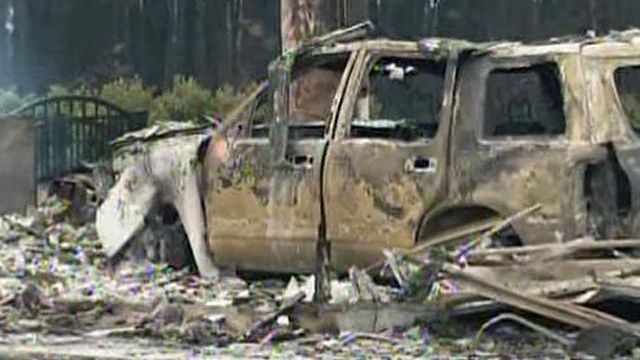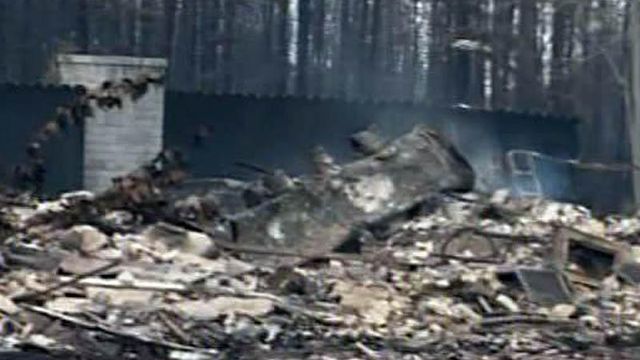Myrtle Beach wildfire S.C.'s biggest in three decades
South Carolina's biggest wildfire in more than three decades – a blaze four miles wide that cut a swath six miles long – destroyed dozens of homes Thursday and threatened some of the area's world-famous golf courses at the height of the spring tourist season.
Posted — UpdatedThe flames, fed by tinder-dry scrubland, forced hundreds of people to flee, and some took shelter in the House of Blues honkytonk.
The fire got within 1½ miles of N.C. Highway 17, the main coastal road that links beachfront towns and is lined with fast-food restaurants, beachwear stores and trinket shops. By Thursday evening, the flames were about 3 miles west of the highway.
The blaze scorched about 24 square miles over the past two days and then veered north, heading away from the high-rise hotels that line Myrtle Beach. There were no reports of injuries, and authorities said they had not determined what sparked the flames.
Fueled by dry underbrush and highly combustible swamp peat, the blaze leveled about 70 homes and damaged 100 others early Thursday as the fire jumped a four-lane highway. The flames also forced authorities to evacuate 2,500 people. Some returned home Thursday evening while, at the same time, a couple of miles north, police told people to leave 30 other homes. Officials said they were worried shifting winds overnight could push the flames farther inland toward other neighborhoods.
Sixty-nine homes were destroyed, and more than 100 others heavily damaged Thursday. Much of the damage was concentrated at Barefoot Landing, a sprawling complex of houses, condominiums and golf courses separated from the main route through Myrtle Beach by the Intracoastal Waterway.
"The house is completely gone," said Rachel Plaga, a 38-year-old nurse, who later began sobbing. "It was like Armageddon back there. There was nothing. Everything was gone. My whole life. My kid's whole life. It was horrific."
Another woman who broke down in tears had to be helped to a seat by a Red Cross worker.
Residents remembered the frantic evacuation in the early hours of Thursday morning.
"All the trees on three sides of us were burning," said Atissa Campbell, who was awakened around 1:30 a.m. "My husband grabbed me. My shoe came off; he wouldn't even let me pick up my shoe."
"It was pretty scary. The police were up the street; they were knocking on all the houses to wake people up," Alan Godfrey recalled.
Garry Alderman, Horry County's fire chief, described some homes as left with only "skeletal remains."
The fire appeared to hopscotch through the neighborhood, which was draped in a thick haze, and some of the rubble still smoldered hours later.
One home was burned to its slab, while the brick house next door appeared undamaged, an American flag still flying.
At another home, the car in the driveway was charred, but the only damage to the house was melted vinyl siding. At one address, everything burned except the garage door, which remained standing.
After they were evacuated, some 200 residents spent the rest of the day in and around the nearby House of Blues, where officials gave them updates. Hours later, they were ushered inside to watch a video of the fire damage because they were not yet allowed to return to their homes. In all, some 450 people sought help at area shelters.
Officials said the blaze appeared to die out at Barefoot Landing by midmorning, only to move parallel to the waterway and away from the area's major golf courses. Authorities worried it could jump the channel, a canal as wide as a football field that separates the city's main drag from the homes of retirees and people who help run the area's golf courses, hotels and other businesses.
A few miles south along the coast, people were unaffected. Golfers kept their tee times, and tourists spread out on the beaches. Hotel managers, who offered vouchers to the evacuees, said they could not even smell the smoke.
North Myrtle Beach Mayor Marilyn Hatley encouraged tourists to keep coming.
"Certainly, come on to the Grand Strand area and enjoy yourself," Hatley said. "There should be no reason why anyone is cancelling their vacation."
Closer to the fire along N.C. 17, though, businesses lost customers, and the thick smoke chased mini-golf customers from Gail Taylor's Hawaiian Village Golf. She had only had customers all day, both evacuees who were trying to kill time.
"I knew it was going to be like this when I opened up this morning," Taylor said. "People aren't going to come out and play golf when they're scared."
The governor declared a state of emergency, and schools closed early.
The fire started several miles inland Wednesday, near subdivisions and golf courses that have been carved from forest and swamps over decades. On Thursday, state forestry officials said they issued two citations to someone for starting a fire that got out of control, but it was unclear whether that person had started the massive blaze.
Late Thursday, the fire had burned approximately 19,600 acres and was 40 percent contained.
The area remains prone to wildfires that spring up in the woods and scrub. Horry County Fire Rescue spokesman Todd Cartner said this week's fire was the worst blaze since some 47 square miles burned in 1976.
Dense vegetation made the fire hard to fight, Cartner said. Crews used plows and tractors to cut firebreaks through heavily grown patches called Carolina Bays.
The shallow, egg-shaped depressions pockmark the coast and range in size from a few acres to thousands of acres. They are densely filled with plant life and often have boggy bottoms where peat, if it catches fire, can burn for days or weeks.
Tropical downpours are often the only thing that can extinguish such fires, said state Forestry Commission spokesman Scott Hawkins.
About 560 firefighters joined backhoes and six airplanes fighting the fire. "We have the resources. We need to get a weather break," said William Bailey, public safety director for North Myrtle Beach.
Myrtle Beach and the surrounding area is the anchor of the state's $16 billion annual tourist industry, drawing college students looking for a cheap spring break destination and families who fill miles of budget hotels in the summer.
Tens of thousands of golfers visit each year, and some of the region's courses are among the best in the nation.
Maureen Hodge and her 79-year-old husband spent the past five weeks enjoying a golf vacation at Barefoot Landing until early Thursday. Hodge, 62, said they left with only what they were wearing and their medications.
The Bangor, Maine, resident said she would like to get back for her golf clubs.
"I don't know if we'll ever come back," she said, laughing. "But this is a once-in-a-lifetime thing."
---
Associated Press writers Meg Kinnard in North Myrtle Beach, and Katrina A. Goggins, Jeffrey Collins and Jack Jones in Columbia contributed to this report.
• Credits
Copyright 2024 by WRAL.com and the Associated Press. All rights reserved. This material may not be published, broadcast, rewritten or redistributed.






